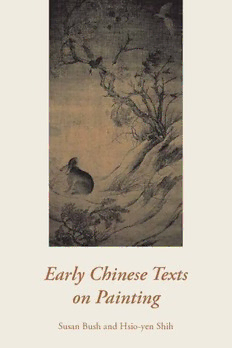Table Of Content(cid:38)(cid:66)(cid:83)(cid:77)(cid:90)(cid:1)(cid:36)(cid:73)(cid:74)(cid:79)(cid:70)(cid:84)(cid:70)(cid:1)(cid:53)(cid:70)(cid:89)(cid:85)(cid:84)(cid:1)
(cid:80)(cid:79)(cid:1)(cid:49)(cid:66)(cid:74)(cid:79)(cid:85)(cid:74)(cid:79)(cid:72)
Susan Bush and Hsio-yen Shih
Early Chinese Texts on Painting
“A Breath of Spring,” dated to 1360, Yüan Dynasty. Plum blossom painting flour-
ished at the end of the Southern Sung Dynasty, and during the Yüan Dynasty
it served as a form of cultural protest against the Mongol regime. This is the
only known work by the Taoist hermit Tsou Fu-lei, whose purity of character
was thought to be reflected in his subject. Handscroll (detail), ink on paper,
34.1 x 223.4 cm. Courtesy of the Freer Gallery of Art, Smithsonian Institution,
Washington, D.C.
Early Chinese Texts on Painting
Susan Bush and Hsio-yen Shih
Hong Kong University Press
The University of Hong Kong
Pokfulam Road
Hong Kong
www.hkupress.org
© Hong Kong University Press 2012
First edition published for Harvard-Yenching Institute by Harvard University
Press, 1985
ISBN 978-988-8139-73-6
All rights reserved. No portion of this publication may be reproduced or
transmitted in any form or by any means, electronic or mechanical,
including photocopy, recording, or any information storage or
retrieval system, without permission in writing from the publisher.
British Library Cataloguing-in-Publication Data
A catalogue record for this book is available
from the British Library.
10 9 8 7 6 5 4 3 2 1
Printed and bound by Goodrich Int’l Printing Co. Ltd., Hong Kong, China
To our teachers
Contents
Preface to the Second Edition ix
Preface to the First Edition xi
Abbreviations xiii
Introduction 1
1 Pre-T’ang Interpretation and Criticism 18
Problems of Representation 24 Optical Illusion 25 Didactic
Subject Matter 25 Definition, Animation, and Expression 28
Training 32 Technique 32 The Significance of
Landscape 36 Criteria for Appreciation and Criticism 39
Social Status and Creative Activity 42
2 T’ang Criticism and Art History 45
The Significance of Painting 48 Origins of Painting 49 Period
and Regional Styles 52 Definition, Animation, and
Expression 53 Training 59 Brushwork 60 Landscape 66
Appreciation and Connoisseurship 71 Classification 75
Criticism 78 Social Status and Creative Activity 85
3 Sung Art History 89
The Significance of Figure Painting 93 Critical
Standards 94 Expressive Style and Quality 95
Brushwork 97 Appreciation and Connoisseurship 98
Classification in Grades by Qualities 100 Classification in Subject
Categories 103 Buddhist and Taoist Subjects 105 Figure
Painting 109 Architectural Subjects 111 Barbarians 113
Dragons and Fishes 114 Landscape 116 Different Models for
Landscapists 120 Domestic and Wild Animals 123
viii Contents
Flowers and Birds 125 Ink Bamboo, Vegetables, and Fruit 128
Classification by Social Status 129 Scholars’ Painting 132
The Emperor as Connoisseur and Artist 134 The Academy of
Painting 137 Southern Sung Monks and Academicians 138
4 The Landscape Texts 141
The Significance of Old Pines 145 The Significance of
Landscape 150 Figures in Landscape 154 On
Creativity 156 Tradition and Models 159 Landscape
Formations 164 Atmosphere and Spatial Recession 168
Technical Secrets 170 Faults of Landscape Painting 180
Connoisseurship of Landscape Painting 184 Kuo Hsi as
Court Artist 187
5 Sung Literati Theory and Connoisseurship 191
The Painter as Artisan or Scholar 196 Character and
Style 201 Poetry and Painting 203 Calligraphy and
Painting 205 The Tao and Painting 206 Naturalness in
Painting 212 Spontaneity in Painting 217 Form and
Principle 220 Definition, Animation, and Expression 224
Mood in Painting 230 Connoisseurship 233
6 Yüan Criticism and Writings on Special Subjects 241
Spirit Resonance and Quality 245 On the Subject Categories of
Painting 247 On Artists’ Styles 249 Scholars’ Painting and the
Spirit of Antiquity 254 Yüan Literati Artists and Critics 255
On Mounting and Collecting 256 Connoisseurship 258
Landscape 262 Figure Painting 270 Bamboo 272
Prunus 280
Biographies of Painters, Critics, and Calligraphers 291
Glossary of Chinese Terms 352
Glossary of Chinese Names and Titles 355
Bibliography 363
Index 379
Illustrations follow p. 146
Preface to the Second Edition
This volume of translations has been out of print now for more than
a dozen years and I am extremely grateful to Hong Kong University
Press for reissuing it, and trust that it will continue to find an audience.
Recently I heard a professor of Chinese art history call this book his
bible, and I do know that in the past students and teachers have found
it a useful tool as it was designed to be. That it succeeded so well was
largely due to two prime movers, Professor James Cahill and my co-edi-
tor Hsio-yen Shih.
James Cahill’s contributions to Chinese art history cannot be overes-
timated, and his chief virtue for students at all levels must be his acces-
sibility and interest in their work. This volume was the outcome of his
translation project started at the University of California, Berkeley, and
eventually funded by the American Council of Learned Societies. After
Hsio-yen Shih and I were chosen as editors, James Cahill continued as
always to offer advice and support.
As for Hsio-yen Shih, better known as Yen, I still regret her death
in 2001. She made contributions in all areas of Chinese art history
while working overtime in different positions. In the early 1980s she
was chosen as an editor for this book because of her research on Sung
painters’ biographies and her translation of the second part of the Li-tai
ming-hua chi of ca. 847, a text that supplies much of the material in the
first two chapters of this book. I was no doubt chosen because of my dis-
sertation on literati art theory and because I could work with Yen.
We made a good team. She outlined the chapters and devised the
approach of presenting excerpts under subject headings so that the
material was more accessible to students. She also suggested that we
each edit chapters in which we had not translated most of the texts. I
thought that chapter introductions would be a helpful overview and
that a general discussion of the Six Laws of painting was necessary in

